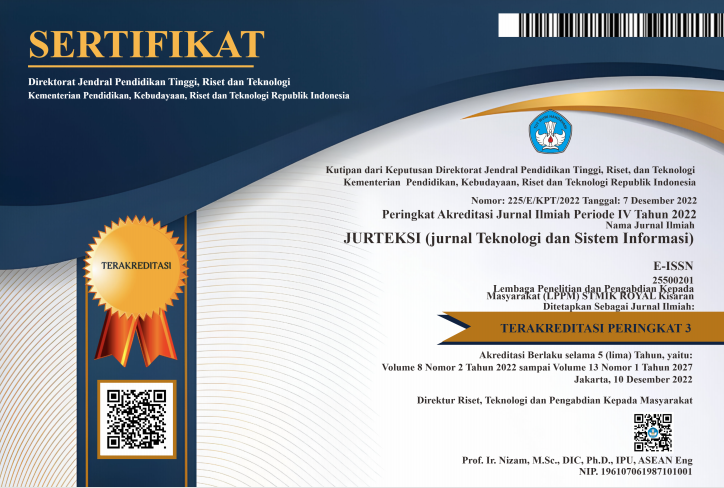ANALYSIS OF PUBLIC OPINION ON INDONESIAN TELEVISION SHOWS USING SUPPORT VECTOR MACHINE
Abstract
Abstract: There are a great number of academics that are now conducting research on sentiment analysis by employing supervised and machine learning techniques. The research can be carried out with the assistance of a variety of sources, including reviews of movies, reviews of Twitter, reviews of online products, blogs, discussion forums, and other social networks. With the progress of technology, individuals may now effortlessly utilize social media platforms to access and share information, as well as express their viewpoints to the general public, without any constraints of distance or time. Twitter is a social media network that serves as a repository for opinions. Diverse techniques are employed to provide optimal and realistically precise pressure detection. The analysis and discussion affirm that the Support Vector Machine (SVM) was effectively employed in this study, utilizing public opinion data on television program reviews in Indonesia. An SVM classifier is employed to examine the Twitter data set by utilizing various parameters. The study successfully completed the preprocessing process by collecting a total of 400 data points, consisting of 320 reviews from 4 television shows for training data and 80 reviews for testing. The data was filtered and classified using SVM, with 200 positive and 200 negative data points for comparison. The experiment utilized the SVM method using TF-IDF to achieve the most accurate test results. The test accuracy was 80%, while the training data accuracy reached 100%.
Keywords: Sentiment Analysis; Support Vector Machine; Television Shows Review, TF-IDF,
Abstrak: Saat ini, banyak akademisi sedang menyelidiki analisis sentimen melalui pemanfaatan teknik yang diawasi dan pembelajaran mesin. Kajian dapat dilakukan dengan menggunakan beberapa sumber seperti review film, review Twitter, review produk online, blog, forum diskusi, atau jejaring sosial lainnya. Dengan kemajuan teknologi, masyarakat kini dapat dengan mudah memanfaatkan platform media sosial untuk mengakses dan berbagi informasi, serta menyampaikan pandangan mereka kepada masyarakat umum, tanpa batasan jarak dan waktu. Twitter adalah jaringan media sosial yang berfungsi sebagai gudang opini. Beragam teknik digunakan untuk menghasilkan deteksi tekanan yang optimal dan presisi secara realistis. Analisis dan pembahasan menegaskan bahwa Support Vector Machine (SVM) efektif digunakan dalam penelitian ini, memanfaatkan data opini publik tentang review program televisi di Indonesia. Pengklasifikasi SVM digunakan untuk memeriksa kumpulan data Twitter dengan memanfaatkan berbagai parameter. Penelitian berhasil menyelesaikan proses preprocessing dengan mengumpulkan total 400 titik data yang terdiri dari 320 review dari 4 acara televisi untuk data pelatihan dan 80 review untuk pengujian. Data disaring dan diklasifikasikan menggunakan SVM, dengan 200 titik data positif dan 200 titik data negatif sebagai perbandingan. Percobaan ini menggunakan metode SVM dengan menggunakan TF-IDF untuk mencapai hasil pengujian yang paling akurat. Akurasi pengujiannya mencapai 80%, sedangkan akurasi data pelatihan mencapai 100%.
Kata kunci: Analisis Sentimen, Review Tayangan Televisi, TF-IDF, Support Vector Machine
References
Raghav Mehta and Shikha Gupta, “Movie Recommendation Systems using Sentiment Analysis and Cosine Similarity,†International Journal for Modern Trends in Science and Technology, vol. 7, no. 01, pp. 16–22, Jan. 2021, doi: 10.46501/ijmtst0701004.
A. Benlahbib and E. H. Nfaoui, “MTVRep: A movie and TV show reputation system based on fine-grained sentiment and semantic analysis,†International Journal of Electrical and Computer Engineering, vol. 11, no. 2, pp. 1613–1626, Apr. 2021, doi: 10.11591/ijece.v11i2.pp1613-1626.
I. Saputra and D. Rosiyadi, “Perbandingan Kinerja Algoritma K-Nearest Neighbor, Naïve Bayes Classifier dan Support Vector Machine dalam Klasifikasi Tingkah Laku Bully pada Aplikasi Whatsapp,†Faktor Exacta, vol. 12, no. 2, p. 101, Jul. 2019, doi: 10.30998/faktorexacta.v12i2.4181.
A. Setiyono and H. F. Pardede, “Klasifikasi Sms Spam Menggunakan Support Vector Machine,†Jurnal Pilar Nusa Mandiri, vol. 15, no. 2, pp. 275–280, Sep. 2019, doi: 10.33480/pilar.v15i2.693.
M. Rangga, A. Nasution, and M. Hayaty, “Perbandingan Akurasi dan Waktu Proses Algoritma K-NN dan SVM dalam Analisis Sentimen Twitter,†JURNAL INFORMATIKA, vol. 6, no. 2, pp. 212–218, 2019, [Online]. Available: http://ejournal.bsi.ac.id/ejurnal/index.php/ji
A. Rahmawati, A. Marjuni, J. Zeniarja, J. Informatika, U. Dian, and N. Semarang, “Analisis Sentimen Publik Pada Media Sosial Twitter Terhadap Pelaksanaan Pilkada Serentak Menggunakan Algoritma Support Vector Machine Public Sentiment Analysis On Twitter Social Media To Pilkada Serentak Event Using Support Vector Machine Algorithm,†2017.
F. Rahutomo, P. Y. Saputra, and M. A. Fidyawan, “Implementasi Twitter Sentiment analysis untuk reviewfilm menggunakan algoritma support vector machine,†Jurnal Informatika Polinema , vol. 4, 2018.
R. Taufiq, A. E. Wardoyo, and R. Pratama, “Analisis Sentimen Pada Twitter Terhadap Kinerja Komisi Pemberantasan Korupsi (Kpk) Di Indonesia Dengan Metode Naive Bayes.â€
S. Al Faraby, “Analisis Dan Implementasi Support Vector Machine Dengan String Kernel Dalam Melakukan Klasifikasi Berita Berbahasa Indonesia Analysis and Implementation Support Vector Machine With String Kernel for Classification indonesian news,†2018.
R. S. Perdana and M. A. Fauzi, “Analisis Sentimen Terhadap Tayangan Televisi Berdasarkan Opini Masyarakat pada Media Sosial Twitter menggunakan Metode K-Nearest Neighbor dan Pembobotan Jumlah Retweet,†2017. [Online]. Available: http://j-ptiik.ub.ac.id
S. Bhatia, M. Sharma, and K. K. Bhatia, “Sentiment Analysis and Mining of Opinions,†in Studies in Big Data, vol. 30, Springer Science and Business Media Deutschland GmbH, 2018, pp. 503–523. doi: 10.1007/978-3-319-60435-0_20.
F. A. Pozzi, E. Fersini, E. Messina, and B. Liu, Sentiment analysis in social networks. 2017.
A. Halik, S. Sos, and M. Si, “Buku Daras Uin Alauddin Komunikasi Massa Universitas Islam Negeri (Uin) Alauddin Makassar,†2013.
W. E. Nurjanah, R. Setya Perdana, and M. A. Fauzi, “Analisis Sentimen Terhadap Tayangan Televisi Berdasarkan Opini Masyarakat pada Media Sosial Twitter menggunakan Metode K-Nearest Neighbor dan Pembobotan Jumlah Retweet,†2017. [Online]. Available: http://j-ptiik.ub.ac.id
G. Ignatow and R. Mihalcea, “An Introduction to Text Mining,†2018.
D. D. Nur Cahyo et al., “Sentiment Analysis for IMDb Movie Review Using Support Vector Machine (SVM) Method,†Inform : Jurnal Ilmiah Bidang Teknologi Informasi dan Komunikasi, vol. 8, no. 2, pp. 90–95, Mar. 2023, doi: 10.25139/inform.v8i2.5700.
R. Friedman, “Tokenization in the Theory of Knowledge,†Encyclopedia, vol. 3, no. 1, pp. 380–386, Mar. 2023, doi: 10.3390/encyclopedia3010024.
Z. Jiang, B. Gao, Y. He, Y. Han, P. Doyle, and Q. Zhu, “Text Classification Using Novel Term Weighting Scheme-Based Improved TF-IDF for Internet Media Reports,†Math Probl Eng, vol. 2021, 2021, doi: 10.1155/2021/6619088.
M. Lan, C. L. Tan, J. Su, and Y. Lu, “Supervised and traditional term weighting methods for automatic text categorization,†IEEE Trans Pattern Anal Mach Intell, vol. 31, no. 4, pp. 721–735, 2009, doi: 10.1109/TPAMI.2008.110.
T. Sabbah et al., “Modified frequency-based term weighting schemes for text classification,†Appl Soft Comput, vol. 58, pp. 193–206, Sep. 2017, doi: 10.1016/j.asoc.2017.04.069.
W. S. Noble, “What is a support vector machine?,†2006. [Online]. Available: http://www.nature.com/naturebiotechnology
E. Beauxis-Aussalet, “Simplifying the Visualization of Confusion Matrix,†2014. [Online]. Available: https://www.researchgate.net/publication/302412429
D. D. Nur Cahyo et al., “Sentiment Analysis for IMDb Movie Review Using Support Vector Machine (SVM) Method,†Inform : Jurnal Ilmiah Bidang Teknologi Informasi dan Komunikasi, vol. 8, no. 2, pp. 90–95, Mar. 2023, doi: 10.25139/inform.v8i2.5700.
N. Ritha et al., “Sentiment Analysis of Health Protocol Policy Using K-Nearest Neighbor and Cosine Similarity,†European Alliance for Innovation n.o., Jan. 2023. doi: 10.4108/eai.11-10-2022.2326274.













